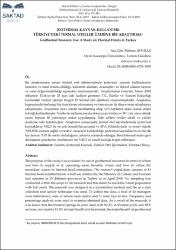Jeotermal kaynak kullanımı: Türkiye’deki termal oteller üzerine bir araştırma
Citation
Boyraz, M . (2019). JEOTERMAL KAYNAK KULLANIMI: TÜRKİYE’DEKİ TERMAL OTELLER ÜZERİNE BİR ARAŞTIRMA. Safran Kültür ve Turizm Araştırmaları Dergisi , 2 (3) , 372-385 . Retrieved from https://dergipark.org.tr/tr/pub/saktad/issue/51489/643695Abstract
Bu araştırmanın amacı termal otel işletmelerinde jeotermal kaynak kullanımının nereden ve nasıl temin edildiği, kullanım alanları, avantajları ve ikincil suların nerede ve nasıl değerlendirildiği açısından incelenmesidir. Araştırmanın evrenini, Nisan 2018 itibariyle Türkiye’de 25 ayrı ilde faaliyet gösteren T.C. Kültür ve Turizm Bakanlığı tarafından turizm işletme belgeli 83 termal otel işletmesi oluşturmaktadır. Araştırma kapsamında herhangi bir örnekleme alınmamış ve tam sayım ile tüm evrene ulaşılmaya çalışılmıştır. Araştırma nicel olarak tasarlanmış olup veri toplama aracı olarak anket tekniği kullanılmıştır. Verilerin toplanmasında dokuzu çevrimiçi ve 31’i yüz yüze olmak üzere toplam 40 yöneticiye anket uygulanmış. Elde edilen veriler sıklık ve yüzde analizine tabi tutulmuştur. Araştırma sonucunda, termal otel işletmelerinde jeotermal kaynakların %82,5 ile en çok termal havuzlarda ve SPA bölümlerinde ve temel olarak %81,8’lik oranda sağlık ve tedavi amacıyla kullanıldığı; jeotermal kaynakların en büyük faydasının %70 ile otelin doluluğunu artırma yönünde olduğu; ikincil termal suları geri dönüşüme gönderme oranlarının ise %42,5 ile sınırlı kaldığı tespit edilmiştir. The purpose of the study is to evaluate the use of geothermal resources in terms of where
and how to supply of it, operating areas, benefits, where and how to utilize the
secondary waters in thermal hotel enterprises. The research population, consists of 83
thermal hotel establishments which are certified by the Ministry of Culture and Tourism
and operates in 25 different provinces in Turkey as of April 2018. No sampling was
conducted within the scope of the research and it is aimed to reach the whole population
with full count. The research was designed as a quantitative method and the as a data
collection tool survey technique was used. To collect the data, a total of 40 managers
were interviewed, nine of whom were online and 31 were face to face. Frequency and
percentage analysis were used to examine obtained data. As a result of the research, it
was found that the thermal springs in were used with 82.5% in thermal pools and SPA
sections, and mainly 81.8% in basic health and treatment; the major benefit of geothermal resources is to increase the occupancy rate of the hotel with 70%; the ratio of sending
secondary thermal waters to recycling was limited to 42.5%.
Source
Safran Kültür ve Turizm Araştırmaları DergisiVolume
2Issue
3Collections
- Makaleler [28]



















